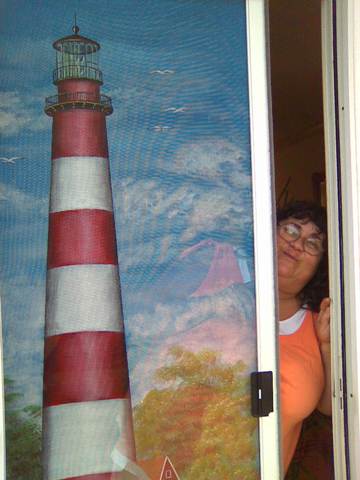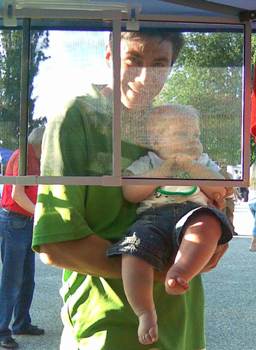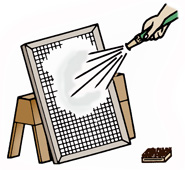about painted screens
"YOU SEE OUT, BUT NO ONE SEES IN"
The painted screens act as a privacy screen.
You can see out but passersby can’t see in.
Read about the science behind the painted screen phenomenon below!
The magical painting is almost invisible from inside your home.
The painted mesh stills allows the breeze to pass through.
You can "Go Green with a Painted [SOLAR] Screen."
The durable painting will last for years with proper care.
See below for instructions on care and maintenance of painted screens.
Decorative screen art is personally hand-painted especially for you!
Screens may be metal, fiberglass, or heavy duty pet-resistant screen. Illuminated lighthouses, 3D effects, personalized themes, and see-through window-like framed art add new twists to the old tradition.
Painted screens can be easily replaced should the need arise.
Beautiful color on the outside, yet invisible from the inside


Why can “you see out,... but no one sees in?”
The Painted Screen Phenomenon: From inside the house, in the daytime, you can see out through the virtually invisible screen as if it wasn't even there. Yet, people outside of your house can see the colorful screen painting very well but they can’t see clearly inside your home.
Why is this?
It’s simple physics, my dear.
It’s all about light. We need light to see.
{NO LIGHT = NO SIGHT}
We see colored objects because light waves (coming from a light source like the sun or a light bulb) hit the object and bounce back from the object onto the retina of our eyes.
Why can you see the screen painting from the outside? Let's start with the easiest explanation first. From the outside the house, daylight bounces off the colored painted screen onto your eyes. The painting is illuminated and therefore it is visible to you.
Why can’t you see inside? This gets a little more complicated. You can’t see through the screen’s tiny dark mesh holes into the house because the indoor objects are basically in the dark (in comparison to the objects that are in the bright daylight). Also, light bouncing off the painted screen onto your eyes tends to overpower the dim indoor light, preventing the contrasting dim indoor light (and corresponding images of the indoor objects) from reaching your eyes.
Then why can’t you see the screen from indoors? The difficulty level is going up with this explanation. At night, in a dark room with the lights off, you don’t see colors, only black, because there is not enough light to reflect off the objects onto your eyes. Similarly, during a bright sunny day, it's comparatively dark indoors. There’s insufficient light falling on and reflecting off of the inside shadowed part of the screen to let you see the colored painting. The dark shadowed screen appears invisible from the inside of the house, as if the painting weren’t there at all.
Then why can you see outside just fine? If you've followed along so far, then you'll get this explanation. The daylight illuminates all the objects and scenery outside. Daylight and the images of the outdoor illuminated objects floods through the small screen mesh holes into your home and onto your eyes. The shadowed mesh appears invisible. So you see outside as if the painting weren’t there at all!
It's worth mentioning that painted screens do not provide privacy at night when the interior lights are on. Also, a hint of the screen painting may be visible from the inside at night.
The screen should be on the exterior of the glass window or door for optimal viewing. Casement and jalousie window screens aren't conducive to traditional exterior screen painting. But, on the other hand, interior casement window screen paintings can create a very different and dramatic effect inside the home, at night, when the sun goes down.
For those with inquisitive minds, here’s a nice little website to further explain how “without light, there would be no sight.”

Care of Your Painted Screen

-
It's recommended that the screens be simply hosed off with a moderate strength spray of water from a garden hose one or more times a year, depending on how dirty they get in their particular location. Test before power-washing.
-
NEVER USE A STIFF BRUSH or scrub the screen because it may scratch or chip off the paint.
-
You may use a very soft dry paint brush to gently remove particles, preferably on the unpainted side, as needed, either before annual hose-cleaning or in between cleanings.
To further preserve your screen and maintain the vibrant colors, coat it with a clear coat, glossy, NON-YELLOWING, outdoor UV protectant acrylic or enamel spray every 2 years, as follows:
-
Remove the screens from the windows.
-
Clean with soft dry brush, hose spray, and let them dry thoroughly.
-
Spray with clear coat outdoors using horizontal overlapping strokes.
-
Wait a few minutes to allow partial drying.
-
Then repeat spraying in verticle strokes to be certain the entire screen has been covered thoroughly.
-
Let screens dry completely before replacing them in windows.
-
Clear coat sprays may be purchased for less than $7 per can at local paint, hardware, and craft and hobby stores, like AC Moore. Care must be taken not to use a shellac or lacquer product that can irreversably turn the painting dull and brown.
Anna's screens are guaranteed against dulling and chipping.
Just call Anna and bring back the screens for any necessary touch-ups.

To learn more about painted screens, visit the Painted Screen Society.org
Great little hardware stores to have screens replaced are
Near
Phone: 410-859-0830
7229 B&A Blvd, Ferndale, Maryland
repairs screens too!
Phone: 410-766-1840